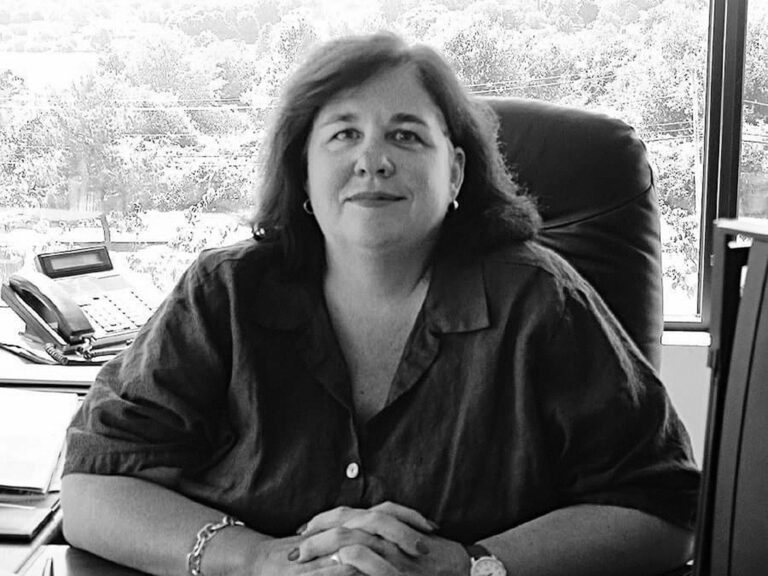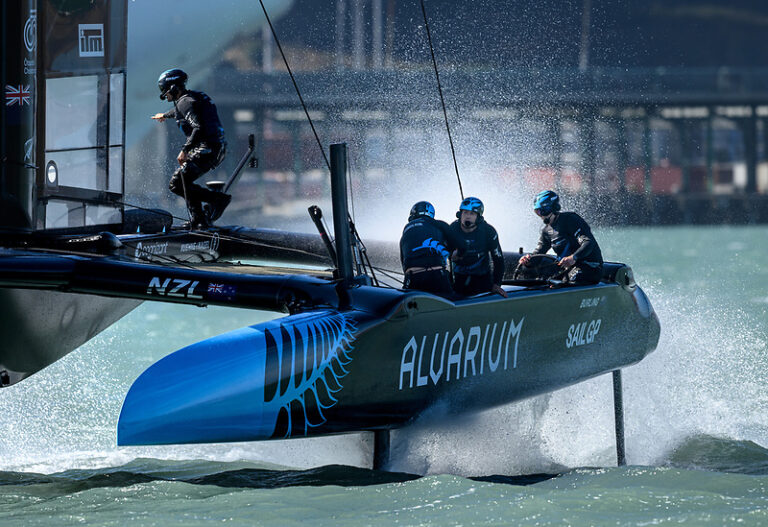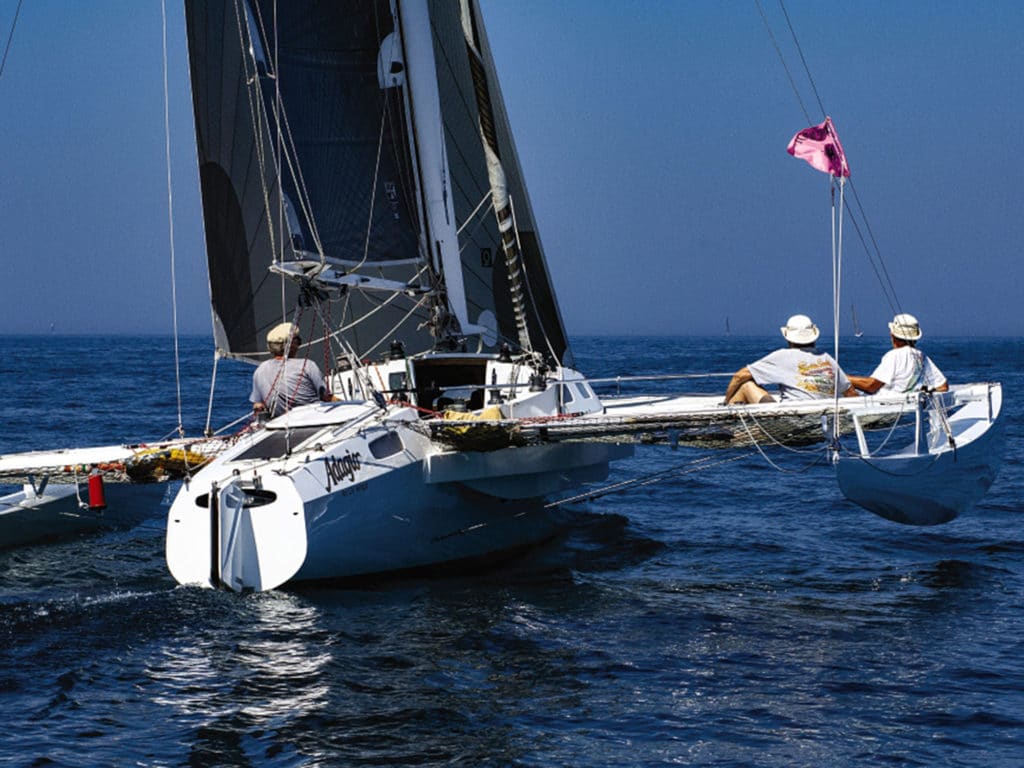
It’s a December night in 2015, and Matt Scharl is restless in the “guest room” set up for him in an office inside Gougeon Brothers boat shop on the bank of the Saginaw River in Bay City, Michigan. Out on the shop floor is the unmistakable white trimaran Adagio, designed and built in 1969 by the Gougeon brothers, Meade and Jan.
Earlier in the day, Scharl stood alongside Meade and Gougeon Brothers’ president and CEO, Alan Gurski, assessing Adagio’s winter worklist. Meade’s primary concern was a 3-foot section of track that kept separating from the mast. Now, late at night and alone, Scharl can’t resist “popping a few screws,” and before long, he’s extracted the entire track. When he finally stops, the track is on the shop floor among chunks of epoxy and bits of wire.
“It’s wasn’t what they had in mind,” Scharl says, recounting the story with a chuckle, “but I did it anyway.”
He finally turned in at 3 a.m., and when he heard voices inside the shop a few hours later, he got up and walked out to the boat to find Gurski and Gougeon bewildered. “With my toothbrush hanging from my mouth,” he says, “I lean in between them and say: “Huh. That was on there when I went to bed.”
That night was the beginning of a transformation for Adagio, the most legendary craft among the tight-knit Great Lakes multihull crowd. Over 50 years of racing this unique and experimental trimaran, the Gougeons amassed a trove of trophies and accolades, but with Meade’s health declining in the years before his passing in 2017, he had handed the responsibility to son Ben and son-in-law Gurski, both of whom seized the opportunity to ensure that the boat remained competitive. Work on boats is what they do at Gougeon, especially in the winter, and they were honored to continue Meade’s great experiment.
“I knew then the boat was famous and unique and had quite a history to it,” Gurski says. “That being said, she was getting old and showing her age. Meade had a philosophy that the boat needed to last only as long as he would last. As he got older, some things on the boat went undone—or got done quickly for another day of sailing.”
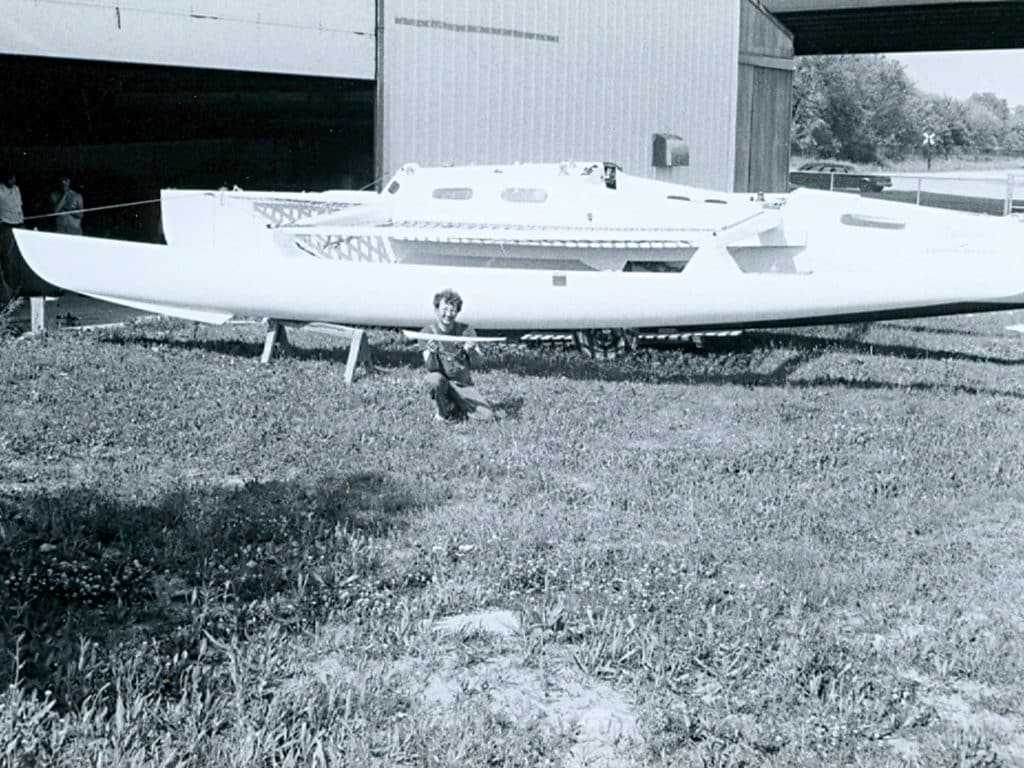
For Ben Gougeon, one of 10 children, the boat was never really more than another vessel used for family outings and weeknight races in the once-thriving Bay City racing scene. As a kid, he says, he was more or less ballast. “Sailing came so naturally to my father, it was hard for him to teach others how to sail. It was more like, pull on that red line until I tell you to stop,” Gougeon says. “At the time, I never appreciated her for what she was. To me, as a kid, it was normal. I didn’t realize the vast differences between Adagio and all the other multihulls.”
Nor did he realize how fast the boat was, and still is today: “It used to drive me crazy because whenever we’d finish a race, my dad would hove to, and we’d sit there and wait for every boat to finish. We’d be around the course in like 20 minutes and then wait for what felt like hours. It wasn’t that he wanted to show everyone that he’d won; he was too humble for that. He just thought it was customary to wait for all the boats to come in, and that’s what he would do. He would talk to people as they came by and congratulate them on a good race and that kind of thing.”
Only once Gougeon, who now works for the company, and Gurski, who also considers himself a late-comer to competitive sailing, started learning how to sail the boat under the tutelage of the Gougeon brothers did they realize what they’d been bestowed. “We fell in love with it,” Gurski says. “Then came the caretaking part of it, which comes from building a relationship with the boat, sailing it and racing. It’s like your dad’s old Chevy; you develop an affection for it, and then find yourself spending an inordinate amount of time maintaining and repairing it. Part of what makes us unique as a crew—and as a family, and us as a company—is that we really like to work with our hands. It’s therapy for us in the boat shop; it keeps us closer to our customers, using our products to constantly maintain and repair our own boats.”
Initially they didn’t really know what the boat needed, but by the second season, they started to have a long-term vision of what its restoration would look like over the next 10 years, being realistic about what was most important—and having the budget to do it right.
“For example, a few years ago, a crack developed in the centerboard trunk, and every time we went over a wave, the boat would fill up with water,” Gurski says. “That winter’s job was to tear the boat in half, tear out the centerboard trunk, and then put it back in. That wasn’t fun.”
It was Meade who eventually enlisted Scharl to assist his son and Gurski himself with updating and racing the boat. “He said he was getting too old to sail Adagio, and he asked me to come to Bay City to help with the boat,” Scharl says. “I said, ‘Sure, but I’d like to sail it once to get an idea of what is involved.’ What I realized right away was that her sails were unforgiving, the lead positions were not optimal, and the hardware was aging on the boat.”
So began Adagio’s transformation at the hands of Gougeon, Gurski and Scharl.
“Over the years, Meade would try stuff, put it on the boat, but then never take it off if it didn’t work. There was a lot of unnecessary stuff on the boat,” Scharl says. “So the primary thing was to simplify it and get a good set of modern sails. It was about making the boat easier to sail. It weighs only 2,600 pounds to begin with, so there wasn’t much room to take much weight out.”
Roughly 300 hours of labor went into the boat in the first year, 200 the next, and by the third, the work list was much smaller. That was when they finally added a traveler, engineered by Gurski and built in-house by the company’s craftsmen. “We had to do quite a bit of reinforcing to support the traveler on the transom,” Gougeon says. “It’s sort of odd the way it’s laid out because there’s a back cabin with a hatch. The traveler currently sits over that hatch, but no one goes back there anyway. It has made a huge difference on the boat. Before, we’d be blowing the sails in the gusts and have to reset them. The traveler greatly simplified the sailing of the boat.”
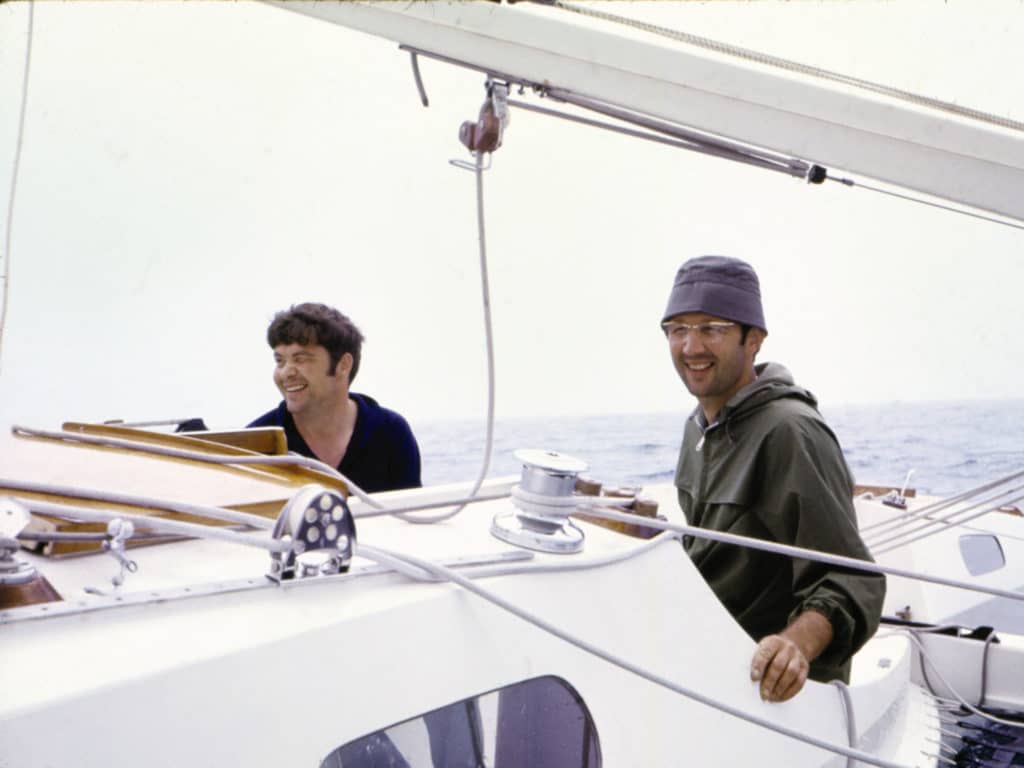
Adagio’s sail number is E5, Gurski explains. The E stands for experiment: “Adagio is Meade’s fifth experiment in boat design and construction, so I like to say there were four failures before it. It took until 1969 to get to Meade’s E5. And it just so happens that Adagio, for what she’s built do to—which is light-air sailing in the Great Lakes—holds true. She’s a light-air machine, and when it’s 8 to 10 knots, any boat in any fleet can’t hold up to her. We could make her stronger, sure, but we’d be hard-pressed to build her stronger at the same weight, or lighter. He got it right, so why change a good thing?”
Gougeon says his father was never really attached to any one particular idea, and that’s why the boat was forever evolving: “He was all for making changes for a tenth more speed and open to any changes that might allow for that. He would try to reduce the weight to make something work better, pushing it lighter and lighter until it broke, and then he’d go back to that point so it didn’t break again.”
Today, not much of his father’s tinkering remains, Gougeon says. Most of the original tiller is there, but everything’s been pretty much replaced on the boat, except the main center hull.
Scharl says Adagio is now close to perfect. “It’s crazy how fast the boat is,” he says, “but the number one thing is how quiet it is. It doesn’t make any noise going through the water. Up to 18 knots downwind, it’s absolutely quiet. Meade’s vision in 1969 is so spot-on today. I look at a lot of designs today, and I’m like, ‘Meh…they’re good, but they’re all condition-based.’ What Adagio does in all conditions is incredible. In winds less than 10 knots, no one is touching that boat. In the right conditions, Adagio would beat every boat by 15 miles—I guarantee that. It destroys TP52s and Great Lakes 70s because it’s incredibly slippery.”
Scharl’s boasts, of course, are backed by results, including a multihull division win in the 2020 Port Huron to Mackinac Race, a brutal upwind slog that saw most of its competitors retire. The previous year, the team of Scharl, Gurski and Gougeon finished second—by 14 seconds—to the 60-foot trimaran Earth Voyager. In 2016, 2017 and 2018 Adagio took home first-place honors. Countless victories beforehand with Meade and Jan and many others on board stand as a testament to its prowess.
Adagio’s results reflect its proof of design, and its construction technique as well, Gougeon says. “It’s been around since the very beginning of the company,” he says, “so, after so many years, it stands out as a longevity thing. This boat was built with no mechanical fasteners in it—other than the stays that hold down the amas. It’s a testament to the epoxy, and certainly as she got faster in the earlier days and won a lot of races, it certainly helped promote West System to what it is today.”
As a sort of sailing shrine to the Gougeon family and the company it built more than 50 years ago, Adagio is an everlasting experiment that continues what they started when they put glue to wood. While nobody has ever tried to buy the boat, Gougeon says, it’s never been for sale anyway. Some things are not for sale, especially something this unique. There’s just not a better experience on a sailboat than Adagio going downwind, surfing waves, Gurski says. The sensation under spinnaker on this boat is magical. The quiet, the speed and the stillness are fantastic—just as Meade knew it would be.







